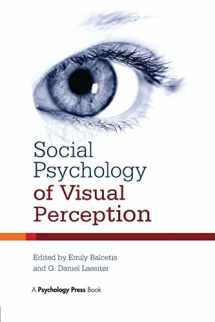
Social Psychology of Visual Perception
ISBN-13:
9781138982260
ISBN-10:
1138982261
Edition:
1
Author:
Emily Balcetis
Publication date:
2015
Publisher:
Routledge
Format:
Paperback
352 pages
FREE US shipping
Book details
ISBN-13:
9781138982260
ISBN-10:
1138982261
Edition:
1
Author:
Emily Balcetis
Publication date:
2015
Publisher:
Routledge
Format:
Paperback
352 pages
Summary
Social Psychology of Visual Perception (ISBN-13: 9781138982260 and ISBN-10: 1138982261), written by authors
Emily Balcetis, was published by Routledge in 2015.
With an overall rating of 4.5 stars, it's a notable title among other
Social Psychology & Interactions
(Psychology & Counseling, General, Psychology, Social Psychology & Interactions) books. You can easily purchase or rent Social Psychology of Visual Perception (Paperback) from BooksRun,
along with many other new and used
Social Psychology & Interactions
books
and textbooks.
And, if you're looking to sell your copy, our current buyback offer is $0.3.
Description
This volume takes a contemporary and novel look at how people see the world around them. We generally believe we see our surroundings and everything in them with complete accuracy. However, as the contributions to this volume argue, this assumption is wrong: people’s view of their world is cloudy at best. Social Psychology of Visual Perception is a thorough examination of the nature and determinants of visual perception, which integrates work on social psychology and vision. It is the first broad-based volume to integrate specific sub-areas into the study of vision, including goals and wishes, sex and gender, emotions, culture, race, and age. The volume tackles a range of engaging issues, such as what is happening in the brain when people look at attractive faces, or if the way our eyes move around influences how happy we are and could help us reduce stress. It reveals that sexual desire, our own sexual orientation, and our race affect what types of people capture our attention. It explores whether our brains and eyes work differently when we are scared or disgusted, or when we grow up in Asia rather than North America. The multiple perspectives in the book will appeal to researchers and students in range of disciplines, including social psychology, cognition, evolutionary psychology, and neuroscience.


We would LOVE it if you could help us and other readers by reviewing the book
Book review

Congratulations! We have received your book review.
{user}
{createdAt}
by {truncated_author}


